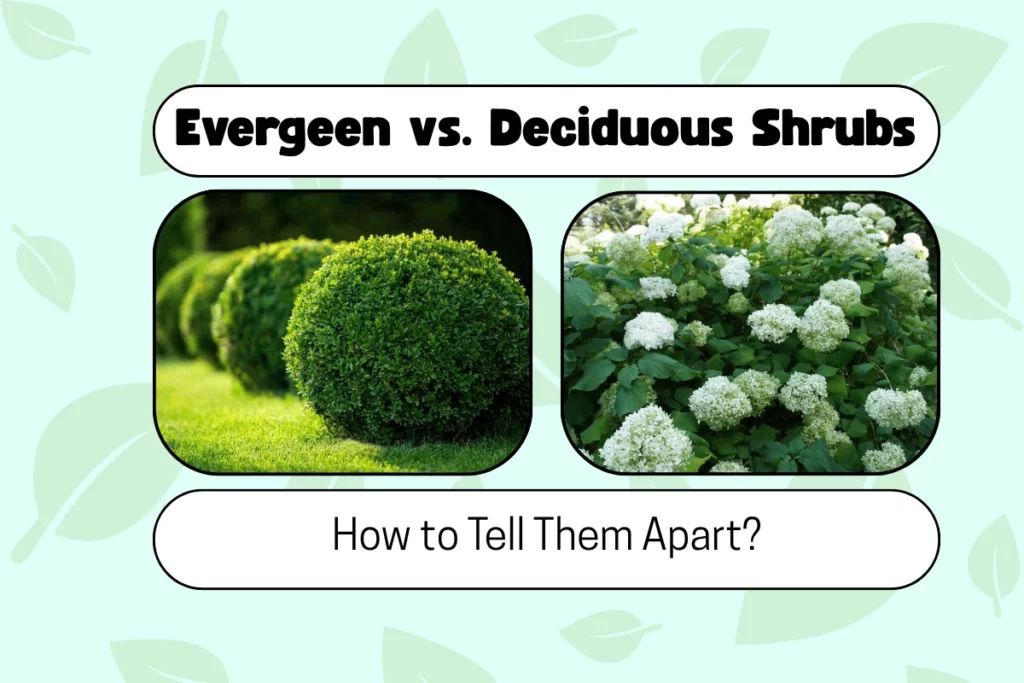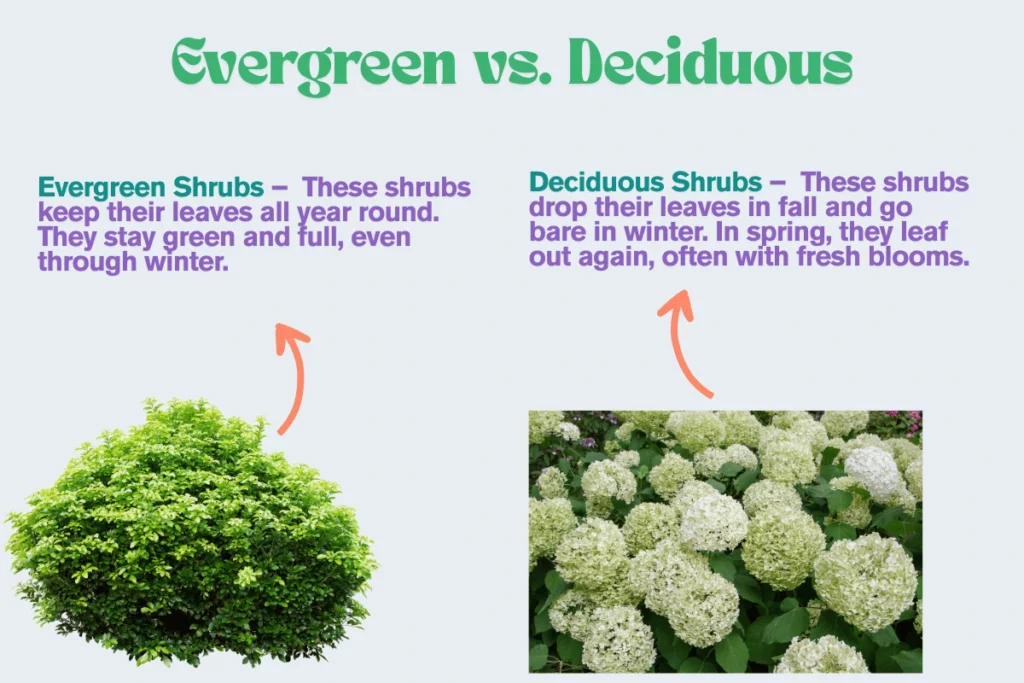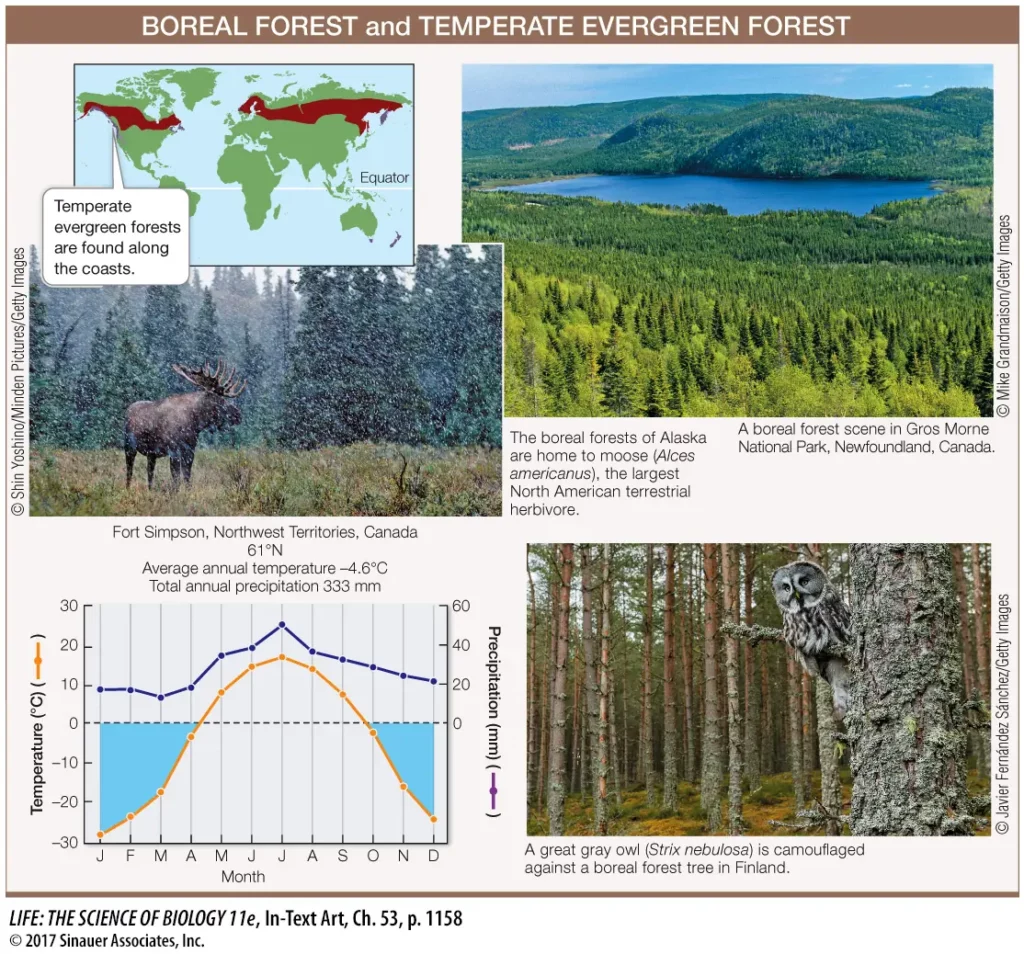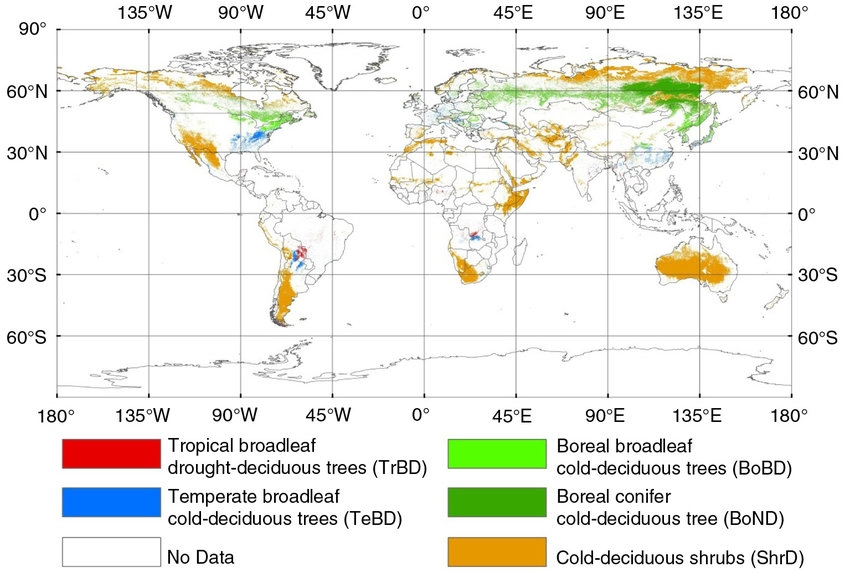
If you’ve ever wondered why some shrubs turn bare in winter while others stay lush, it comes down to one thing: evergreen vs. deciduous shrubs. Understanding how they differ makes a big difference when it comes to choosing plants that suit your climate, style, and maintenance goals. This blog post covers the key traits, visual clues, and tips to help you pick the right one for your garden. Let’s dive in!
Why Knowing the Difference Between Evergreen vs. Deciduous Shrubs Is Useful
Shrubs generally fall into two categories: evergreen and deciduous.
- Evergreen shrubs keep their leaves all year. They stay green through every season, even in winter.
- Deciduous shrubs lose their leaves in fall and go bare during the colder months. In spring, they grow new leaves and often flower.

Knowing which type you’re dealing with is more than just a plant trivia fact. It helps you make smarter decisions for your garden, both in terms of its appearance and its long-term performance.
Here’s why it matters:
- Seasonal appearance: Evergreens provide year-round greenery, while deciduous shrubs change with the seasons, offering dramatic fall color.
- Garden planning: Use evergreens for structure, privacy, or winter interest. Use deciduous shrubs to add seasonal blooms and movement.
- Maintenance needs: Deciduous shrubs may need leaf cleanup and pruning at specific times of year. Evergreens usually need lighter, more consistent care.
- Climate fit: Some plants are better suited to cold conditions without leaves. In colder areas, many native shrubs are naturally deciduous.
- Better plant ID: Understanding these traits makes it easier to recognize shrubs at different times of the year, even when they look entirely different in winter.
Key Differences Between Evergreen vs. Deciduous Shrubs
While both types of shrubs serve important roles in a garden, they behave very differently throughout the year. Below is a simple comparison to help you see how evergreen vs. deciduous shrubs differ in appearance, care, and use.
| Aspect | Evergreen Shrubs | Deciduous Shrubs |
| Leaf behavior | Stay green year-round | Drop leaves in fall, regrow in spring |
| Winter appearance | Full and green | Bare branches, no leaves |
| Leaf texture | Thick, waxy, sometimes needle-like | Soft, flat, often colorful in fall |
| Garden use | Structure, privacy, winter coverage | Seasonal color, flowering, soft texture |
| Maintenance | Light, ongoing pruning | Seasonal cleanup, timing based on bloom cycle |
Now let’s explore each of these five aspects in more detail, so you can clearly understand how evergreen and deciduous shrubs differ and how those differences affect what you see, what you do, and what your garden becomes.
Leaf Behavior and Seasonal Cycle
- Evergreen shrubs
They keep their leaves year-round, but that doesn’t mean individual leaves last forever. A single evergreen leaf can remain on the plant for 2 to 5 years before falling off. This slow turnover gives the plant a consistent look even in harsh conditions. Because these shrubs don’t shut down in winter, photosynthesis continues, just at a slower rate.
- Deciduous shrubs
They drop their leaves all at once, usually in autumn. This is a survival tactic: by shedding foliage, they reduce moisture loss and protect themselves from cold damage. During winter, they enter endodormancy, a deep rest period triggered by changes in temperature and daylight. Once soil temperatures rise above 7–10°C, most deciduous shrubs begin producing buds again. Some species, like forsythia, are so finely tuned to seasonal cycles that they flower before the leaves even return.
Leaf Texture, Color, and Structure
- Evergreen shrubs
Evergreens typically have leaves that are thick, leathery, and often coated in a waxy layer called a cuticle, which helps minimize water loss. In broadleaf evergreens like camellia or holly, leaf thickness frequently ranges from 0.4 to 1.2 mm, offering durability against wind, salt, or frost. Needled evergreens, such as juniper or arborvitae, feature a narrow shape and sunken stomata (tiny pores) to further reduce evaporation. Some even contain resins that act as natural antifreeze.
- Deciduous shrubs
Deciduous trees tend to have thinner leaves, typically ranging from 0.1 to 0.3 mm in thickness, which allows for a larger surface area to capture sunlight during the active growing season. These shrubs invest heavily in their foliage during spring and summer, which is why many have striking fall colors.
The change in pigment isn’t just beautiful; it’s a biochemical phenomenon. As chlorophyll breaks down, compounds like anthocyanins and carotenoids emerge, giving you brilliant reds, oranges, and golds. Some shrubs, like oakleaf hydrangea, even hold their scarlet leaves into early winter if frost arrives gradually.
Function and Role in Garden Design
- Evergreen shrubs
They offer a steady, structural presence in the landscape. Because they retain foliage all year, they’re ideal for hedges, screens, and focal points. Species like boxwood and yew can be pruned into clean shapes, and their slow growth, typically under 15–20 cm per year, means less frequent trimming. These shrubs are especially valuable in winter when little else is green, and they help define space even when perennials die back.
- Deciduous shrubs
They contribute seasonal flair. Many bloom spectacularly, such as spirea or lilac, producing flowers on either new or old wood, depending on the variety. Their growth is often faster; some can shoot up 30–60 cm per season, and their form changes dramatically throughout the year.
In summer, they provide dense foliage and shade. In the fall, their color shift adds drama. And in winter, shrubs with textured bark or bright stems (like red-twig dogwood) can offer visual interest despite having no leaves.
Maintenance and Care
Both types have upkeep, but their schedules differ.
For evergreens:
- Pruning is mostly for shape and size, often done in late spring or after flowering
- Annual inspection helps remove old or damaged foliage
For deciduous shrubs:
- Fall cleanup is vital to prevent disease from decaying leaves
- Pruning after bloom ensures proper shape and encourages next year’s flowers
Climate Adaptation and Survival Strategies
- Evergreen shrubs
Evergreens dominate in areas where winters are milder or soil conditions are poor. Their tough leaves give them a competitive edge in dry or windy environments. In fact, many thrive in USDA zones 7–10, though some, like dwarf Alberta spruce, survive in zone 3. Their water-efficient design makes them a good choice for xeriscaping or gardens exposed to salt spray, like coastal areas.

Boreal and temperate evergreen forest overview
- Deciduous shrubs
In contrast, deciduous shrubs are more common in regions with firm seasonal shifts. Their leaf-shedding habit allows them to handle cold winters and summer droughts. Native species often outperform imports in these conditions because they’ve evolved for local stress patterns.
For instance, native elderberry (Sambucus canadensis) not only survives winter freezes but also supports local pollinators and birds by producing berries in late summer. Interestingly, some shrubs blur the lines between these categories. Semi-evergreens like nandina may keep their leaves in mild winters but drop them in harsher zones. Others, like euonymus, vary in behavior depending on microclimate or soil condition.

Distribution of cold- and drought-deciduous vegetation
Which Should You Choose for Your Garden?
When planning your garden, it really comes down to what you want from the space.
Do you prefer a green, low-maintenance landscape that looks the same year-round? Or do you enjoy watching plants transform with each season: budding in spring, filling out in summer, and changing color in fall?
Understanding the differences between evergreen vs. deciduous shrubs helps you choose plants that match your style, your climate, and the effort you’re willing to put in. Here are a few quick tips to guide your decision:
- For privacy and structure year-round → go with evergreen shrubs like boxwood, laurel, or yew
- For flowers, seasonal color, and dynamic change → choose deciduous shrubs like spirea, viburnum, or hydrangea
- For a balanced, layered look → combine both. Evergreens form the backdrop, while deciduous shrubs bring movement and color throughout the year
Conclusion
Hope this detailed guide will help you understand the key differences between evergreen vs. deciduous shrubs and what they mean for your garden. The more you know, the easier it becomes to plan, plant, and care with confidence. Need quick plant ID? Open the Planteyes app and let it do the work.
FAQs
What is the difference between evergreen vs. deciduous shrubs?
Evergreen shrubs retain their leaves throughout the year, remaining green even in winter. Deciduous shrubs lose their leaves in fall and grow new ones in spring. This seasonal difference affects their look, maintenance, and garden role.
Are evergreen shrubs easier to care for than deciduous ones?
In general, evergreen shrubs require light but steady upkeep, while deciduous shrubs need more seasonal care like fall cleanup and timed pruning. It depends on your garden goals and how hands-on you want to be.
Evergreen vs. deciduous shrubs: Which type is better for cold climates?
Deciduous shrubs are often better suited to colder regions. Shedding their leaves helps them survive frost and snow. That said, some cold-hardy evergreens, such as dwarf spruce, can also thrive in cold zones.
How can I tell what type of shrub I have?
Look at leaf texture, winter appearance, and growth patterns. Still unsure? Use the Planteyes app to snap a photo and instantly identify whether it’s an evergreen or deciduous shrub, even in winter.


